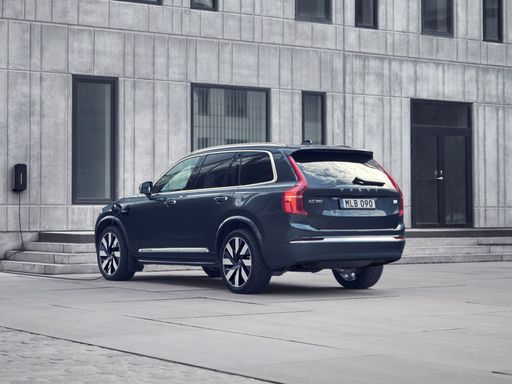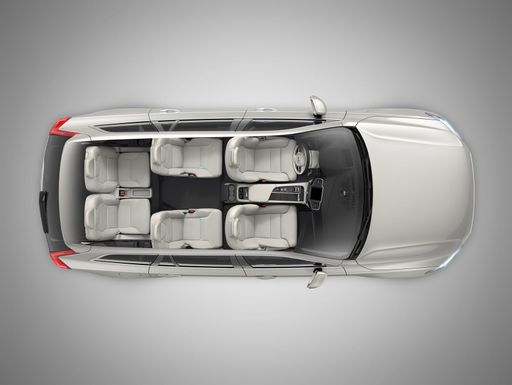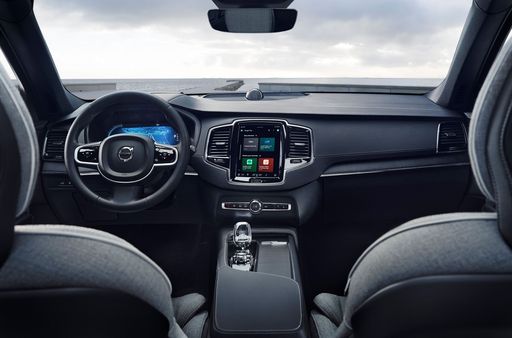The automotive landscape is increasingly dominated by innovative SUVs, and two contenders that have made waves are the Kia Sorento and the Volvo XC90. Both models offer a unique blend of style, technology, and performance, but they differ significantly in design philosophy, technical specifications, and innovations. In this comparison, we’ll delve into what each SUV brings to the table for the 2024 model year.
Kia Sorento vs Volvo XC90 – Performance, range & efficiency compared
Two cars, one duel: Kia Sorento meets Volvo XC90.
Which one wins in performance, efficiency and value for money? Find out now!
Design and Dimensions
The Kia Sorento stands at a length of 4,815 mm, with a width of 1,900 mm and a height of 1,695 mm. Its bold and rugged design is aimed at appealing to adventurous families, providing ample space for up to seven passengers. The cabin is complemented by a practical trunk capacity ranging from 175 to 705 liters, depending on the seating configuration.
On the other hand, the Volvo XC90 is larger, measuring 4,953 mm in length, 1,923 mm in width, and 1,771 mm in height. This size translates into a more luxurious interior experience, accommodating seven passengers with ease. However, it has a smaller trunk capacity, offering between 262 to 302 liters, which may be a consideration for families needing extra cargo space.
Powertrains and Performance
The Kia Sorento offers a more diverse lineup of powertrains, including plugin hybrids, full hybrids, and a diesel option. Its engine range provides power outputs from 194 HP to 252 HP, coupled with torque figures reaching up to 440 Nm. The Sorento boasts impressive fuel consumption figures, with hybrid variants achieving as low as 1.6 L/100 km and a CO2 emission rating as efficient as 37 g/km.
In contrast, the Volvo XC90 showcases a two-engine setup, with a petrol mild-hybrid and a potent plugin hybrid option offering an astonishing 455 HP. The XC90's electric range is rated at up to 71 km, making it an appealing choice for environmentally conscious drivers. The performance specifications are equally compelling, with the XC90 achieving 0-100 km/h in just 5.4 seconds, establishing itself as the sportier option of the two.
Driving Experience and Handling
Both SUVs feature all-wheel drive systems, enhancing traction and stability. The Kia Sorento offers various driving modes that allow drivers to adapt to different conditions and preferences. The automatic transmission facilitates smooth gear transitions, ensuring a pleasant driving experience whether navigating city streets or taking on off-road trails.
Volvo, renowned for its focus on safety and refinement, does not disappoint with the XC90. The ride quality is plush and composed, with an emphasis on comfort that makes it ideal for long-distance journeys. Its higher curb weight of 2,080 kg (or 2,297 kg for the PHEV) contributes to a feeling of robustness on the road.
Technology and Safety Innovations
In terms of technological innovations, both SUVs come equipped with an array of advanced features. The Kia Sorento is bolstered by a user-friendly infotainment system, integrating Apple CarPlay and Android Auto, along with advanced driver-assistance systems that enhance overall safety.
Meanwhile, the Volvo XC90 is laden with premium technology offerings, including a high-quality sound system and a cutting-edge interface that features over-the-air updates for software improvements. The XC90 also places a high premium on safety, with numerous active and passive features that have contributed to its excellent safety ratings worldwide.
Conclusion
Choosing between the Kia Sorento and the Volvo XC90 ultimately boils down to personal preference and priorities. The Sorento presents itself as a versatile family SUV with a range of engine options and impressive fuel economy, while the XC90 is the epitome of luxury and performance, coupled with state-of-the-art safety technology. As both brands continue to innovate, drivers can expect even more exciting developments in the years ahead in the world of SUVs.
Here’s where it gets real: The technical differences in detail
Costs and Efficiency:
Price and efficiency are often the first things buyers look at. Here it becomes clear which model has the long-term edge – whether at the pump, the plug, or in purchase price.
Kia Sorento has a clearly advantage in terms of price – it starts at 46000 £, while the Volvo XC90 costs 69800 £. That’s a price difference of around 23742 £.
Fuel consumption also shows a difference: Kia Sorento manages with 1.60 L and is therefore convincingly more efficient than the Volvo XC90 with 3.50 L. The difference is about 1.90 L per 100 km.
As for range, the Volvo XC90 performs distinct better – achieving up to 71 km, about 16 km more than the Kia Sorento.
Engine and Performance:
Power, torque and acceleration say a lot about how a car feels on the road. This is where you see which model delivers more driving dynamics.
When it comes to engine power, the Volvo XC90 has a convincingly edge – offering 455 HP compared to 252 HP. That’s roughly 203 HP more horsepower.
In acceleration from 0 to 100 km/h, the Volvo XC90 is decisively quicker – completing the sprint in 5.40 s, while the Kia Sorento takes 8.80 s. That’s about 3.40 s faster.
In terms of top speed, the Kia Sorento performs somewhat better – reaching 201 km/h, while the Volvo XC90 tops out at 180 km/h. The difference is around 21 km/h.
There’s also a difference in torque: Volvo XC90 pulls evident stronger with 709 Nm compared to 440 Nm. That’s about 269 Nm difference.
Space and Everyday Use:
Whether family car or daily driver – which one offers more room, flexibility and comfort?
Both vehicles offer seating for 7 people.
In curb weight, Kia Sorento is a bit lighter – 1854 kg compared to 2080 kg. The difference is around 226 kg.
In terms of boot space, the Kia Sorento offers decisively more room – 705 L compared to 302 L. That’s a difference of about 403 L.
In maximum load capacity, the Kia Sorento performs somewhat better – up to 2100 L, which is about 244 L more than the Volvo XC90.
When it comes to payload, Volvo XC90 barely noticeable takes the win – 710 kg compared to 684 kg. That’s a difference of about 26 kg.
Who comes out on top?
Overall, the Kia Sorento shows itself to be wins the duel decisively and secures the title of DriveDuel Champion.
It convinces with the more balanced overall package and proves to be the more versatile choice for everyday use.
 @ Kia Corporation
@ Kia Corporation
Kia Sorento
Kia Sorento
The Kia Sorento is a versatile SUV that seamlessly blends style and practicality, making it an appealing choice for families and adventurers alike. With its spacious interior and thoughtful design features, it ensures a comfortable driving experience on both urban roads and country excursions. Additionally, the Sorento offers a suite of advanced safety technologies, enhancing peace of mind for its passengers.
details @ Kia Corporation
@ Kia Corporation
 @ Kia Corporation
@ Kia Corporation
 @ Kia Corporation
@ Kia Corporation
Volvo XC90
The Volvo XC90 is a serene Scandinavian SUV that mixes minimalist luxury with a composed, confidence-inspiring presence — ideal for buyers who want family practicality without sacrificing style. Inside it serves up a calm, well-crafted cabin and user-friendly tech that keeps long journeys pleasant and tantrums to a minimum, making the XC90 a smart, stylish pick for sensible drivers.
details @ Volvo Cars
@ Volvo Cars
 @ Volvo Cars
@ Volvo Cars
 @ Volvo Cars
@ Volvo Cars
 @ Volvo Cars
@ Volvo Cars
 @ Volvo Cars
@ Volvo Cars
 @ Kia Corporation
@ Kia Corporation
|
 @ Volvo Cars
@ Volvo Cars
|
|
|
|
Costs and Consumption |
|
|---|---|
|
Price
46000 - 59300 £
|
Price
69800 - 84600 £
|
|
Consumption L/100km
1.6 - 7.2 L
|
Consumption L/100km
3.5 - 8.5 L
|
|
Consumption kWh/100km
-
|
Consumption kWh/100km
-
|
|
Electric Range
55 km
|
Electric Range
71 km
|
|
Battery Capacity
-
|
Battery Capacity
14.70 kWh
|
|
co2
37 - 174 g/km
|
co2
79 - 191 g/km
|
|
Fuel tank capacity
47 - 67 L
|
Fuel tank capacity
71 L
|
Dimensions and Body |
|
|---|---|
|
Body Type
SUV
|
Body Type
SUV
|
|
Seats
5 - 7
|
Seats
7
|
|
Doors
5
|
Doors
5
|
|
Curb weight
1854 - 2105 kg
|
Curb weight
2080 - 2297 kg
|
|
Trunk capacity
175 - 705 L
|
Trunk capacity
262 - 302 L
|
|
Length
4810 - 4815 mm
|
Length
4953 mm
|
|
Width
1900 mm
|
Width
1923 mm
|
|
Height
1695 mm
|
Height
1771 mm
|
|
Max trunk capacity
1988 - 2100 L
|
Max trunk capacity
1816 - 1856 L
|
|
Payload
455 - 684 kg
|
Payload
653 - 710 kg
|
Engine and Performance |
|
|---|---|
|
Engine Type
Plugin Hybrid, Full Hybrid, Diesel
|
Engine Type
Petrol MHEV, Plugin Hybrid
|
|
Transmission
Automatic
|
Transmission
Automatic
|
|
Transmission Detail
Automatic Gearbox, Dual-Clutch Automatic
|
Transmission Detail
Automatic Gearbox
|
|
Drive Type
All-Wheel Drive, Front-Wheel Drive
|
Drive Type
All-Wheel Drive
|
|
Power HP
194 - 252 HP
|
Power HP
250 - 455 HP
|
|
Acceleration 0-100km/h
8.8 - 9.7 s
|
Acceleration 0-100km/h
5.4 - 7.7 s
|
|
Max Speed
183 - 201 km/h
|
Max Speed
180 km/h
|
|
Torque
367 - 440 Nm
|
Torque
360 - 709 Nm
|
|
Number of Cylinders
4
|
Number of Cylinders
4
|
|
Power kW
142 - 185 kW
|
Power kW
184 - 335 kW
|
|
Engine capacity
1598 - 2151 cm3
|
Engine capacity
1969 cm3
|
General |
|
|---|---|
|
Model Year
2024
|
Model Year
2024 - 2025
|
|
CO2 Efficiency Class
B, E, F
|
CO2 Efficiency Class
G, B
|
|
Brand
Kia
|
Brand
Volvo
|
What drivetrain options does the Kia Sorento have?
The Kia Sorento is available as All-Wheel Drive or Front-Wheel Drive.
The prices and data displayed are estimates based on German list prices and may vary by country. This information is not legally binding.
